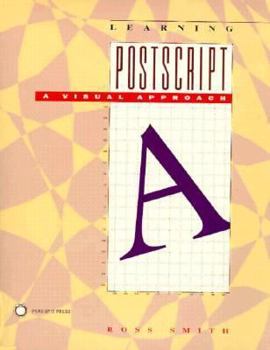Learning PostScript: A Visual Approach
Select Format
Select Condition 
Book Overview
Oriented toward graphic artists and other nonprogrammers, this book teaches the powerful PostScript laser printer language using a unique visual feedback approach. Building from simple examples, the... This description may be from another edition of this product.
Format:Paperback
Language:English
ISBN:0938151126
ISBN13:9780938151128
Release Date:January 1990
Publisher:Peachpit Press
Length:23 Pages
Weight:1.51 lbs.
Dimensions:0.8" x 7.0" x 9.0"
Customer Reviews
5 ratings
Learn PostScript now! From this book!
Published by Thriftbooks.com User , 18 years ago
This book is useful to people employed or interested in graphics, desktop design, document engineering, or programming. It will help you better understand any of these topics. PostScript, developed by Adobe, is the language "under the hood" of PDFs, many layout programs, and a category of printers. It's a full-fledged programming language that's pretty much dedicated to graphics, letting you get at the elements of lines, shapes, shading, and color. And it is becoming even more relevant. Before a document can be made into a PDF, traditionally it has had to be converted into postscript (.ps), and even Microsoft has given a little territory in that direction by their attempts to include automatic creation of PDFs in Office 2007. PostScript is relatively easy to learn and can also diversify your understanding of programming concepts. Unlike varieties of C or Java, PostScript is a "reverse Polish notation" language, which means that the parameters are stated prior to the relevant commands. Like "144 144 lineto" will draw a line to the coordinates listed. It is also "stack-oriented," so I find that it's a little easier to visualize what is happening as I work through the code. Because it's so graphics-directed, PostScript obviously lends itself to the "visual approach." Most of the basic commands resemble actual everyday words, so you can learn rapidly before you even know you are programming. In other words, you don't have to be a programmer or script writer to learn PostScript. And this particular book makes learning PostScript basics easy. It gives code on one page and then shows what happens next to it. It starts with the basics of positioning on the page, and then adds commands that extend the complexity and richness of the illustrations. It also does a good job introducing the programming concepts such as RPN and stack arithmetic. Over the years, PostScript has evolved into a more complex language, incorporating numerous commands that extend the language and concatenate groups of simpler commands (such as a command to draw a box rather than 4 commands to draw the sides). But the book sticks with the basics, and slowly extends your knowledge and skills. Like other programming languages, PostScript includes techniques like recursion, definitions of variables, definitions of complex tasks, mathematics, etc. PostScript is not object-oriented. As a graphics description programming language, PostScript needs some type of compiler for you to see what your code actually draws. This traditionally involves an accompanying program called "ghostscript" that allows the user to see the results in nearly real time. I personally don't care much for ghostscript and often used Adobe Distiller and created PDFs to see the results. Those who don't have Distiller can install and use ghostscript, and that is covered in the book. Since PostScript is a relatively mature technology, there are a lot of older books available, as well as a plethora of web sites and a
PostScript for Dummies
Published by Thriftbooks.com User , 19 years ago
I bought this book in 1994 when I had absolutely no clue about programming. It was a real eye-opener, and to this day it's my reference bible with regard to PostScript. Highly recommended.
Extremely good book
Published by Thriftbooks.com User , 20 years ago
Simple, concise, yet by no means limited. I learned essentially all the postscript that I needed to know for my job in about 3 hours reading this book. Excellent examples, easy to follow, what could more could you ask for?
An excellent resource!
Published by Thriftbooks.com User , 20 years ago
This is a wonderful starting point for learning postscript. It takes you step by step through a very complex topic in a way that is easy to understand as well as offering opportunities to practice what you are learning. I recommend it highly!
Great introduction to Postscript programming
Published by Thriftbooks.com User , 25 years ago
This book offers clear, simple examples and covers the basic Postscript concepts in a way that makes it easy to apply them to real-life situations.I borrowed this book froma friend, and I have GOT to add it to my library -- a must-have!





